Plant dusting with diatomaceous earth involves applying a thin layer of this silica-based powder around your indoor plants’ soil to create a natural pest barrier. You’ll use food-grade diatomaceous earth, which contains fossilized diatom remains that dehydrate common pests like aphids, ants, and fungus gnats upon contact. This safe, chemical-free method protects your plants without toxic residues, though you’ll need to reapply after watering. Continue below to master proper application techniques and maximize effectiveness.
Understanding Diatomaceous Earth Composition and Origins
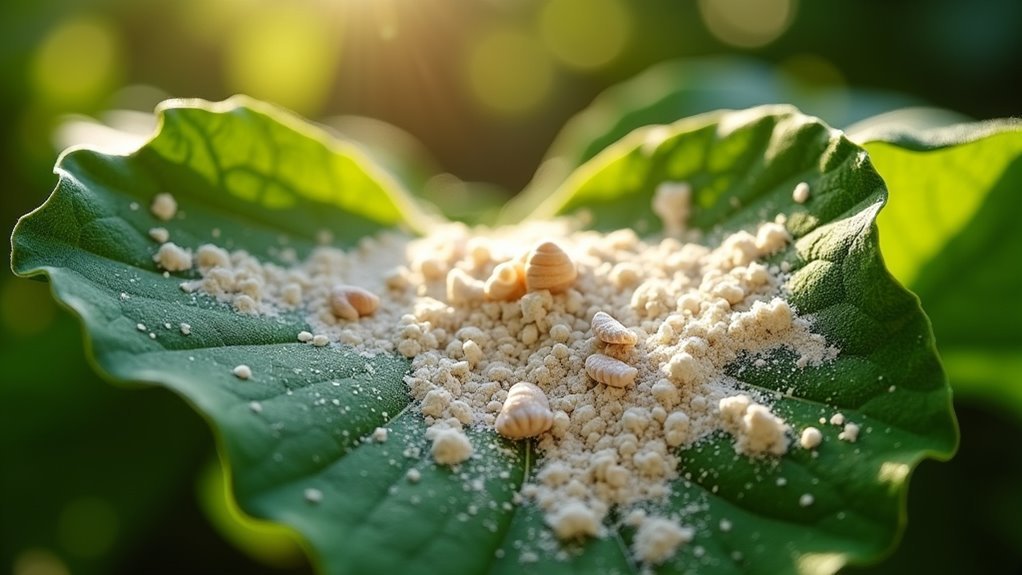
When you examine diatomaceous earth under a microscope, you’ll discover it’s composed of fossilized remains from tiny aquatic organisms called diatoms that lived millions of years ago.
These microscopic creatures possessed silica-based shells that accumulated in ancient freshwater lake beds, forming deposits over extensive geological periods.
You’ll find that diatomaceous earth contains approximately 80-90% silica, which gives it remarkable abrasive and pest control properties.
Its origins trace back to the Eocene epoch, roughly 56 million years ago, making it an ancient geological material.
There are two distinct types you should know about: food-grade diatomaceous earth, which is safe for consumption, and industrial-grade, which isn’t suitable for ingestion.
Understanding this composition helps explain why it’s so effective for plant dusting applications.
Pest Control Benefits for Indoor Plants
While chemical pesticides can harm your family and pets, diatomaceous earth offers a completely safe alternative that effectively controls indoor plant pests without toxic residues.
When you dust your houseplants with diatomaceous earth, you’re creating a powerful barrier against ants, aphids, and fungus gnats. This natural solution works by forming a protective layer on your soil surface that disrupts pest activity.
You’ll find that diatomaceous earth provides long-lasting protection, though you’ll need to reapply it after watering or soil disturbance.
Regular monitoring combined with diatomaceous earth applications markedly reduces infestation risks. For enhanced results, you can combine diatomaceous earth with other natural methods like neem oil and beneficial insects to maximize your plant health and pest management effectiveness.
Essential Safety Precautions During Application
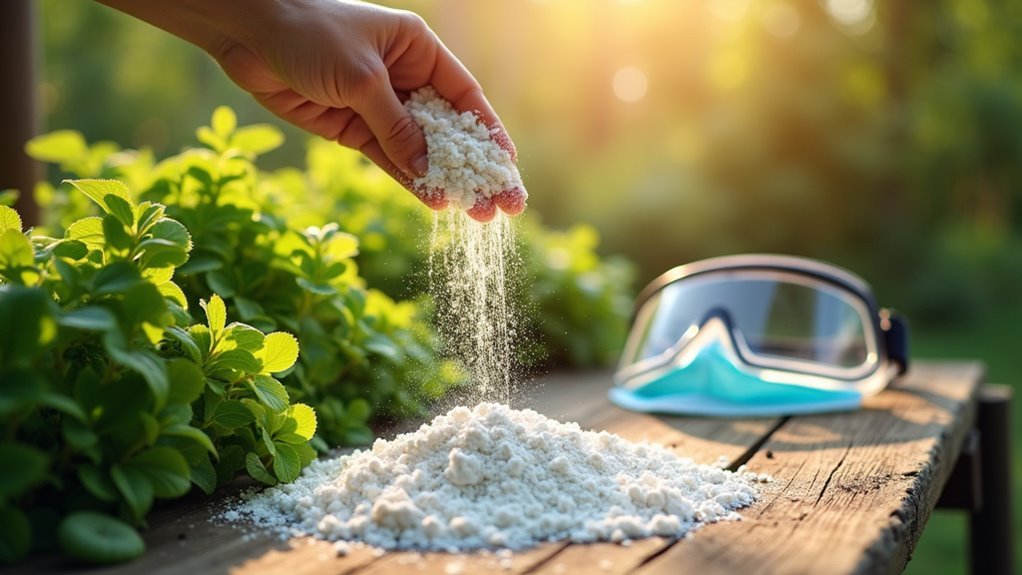
Proper safety measures protect both you and your household during diatomaceous earth application.
You’ll need to follow specific protocols to guarantee everyone’s wellbeing while maintaining the product’s effectiveness.
Essential precautions include:
- Wear protective gear – Always use a dust mask when applying diatomaceous earth to prevent respiratory irritation from fine particles that can become airborne during application.
- Avoid direct foliage contact – Don’t apply diatomaceous earth directly onto plant leaves, as it can cause dehydration and damage to your plants’ delicate foliage.
- Secure the area – Keep diatomaceous earth away from children and pets to prevent accidental ingestion, which becomes harmful in large quantities.
- Handle with care – Minimize dust exposure through gentle handling techniques, guaranteeing your application process remains both safe and effective throughout.
Step-by-Step Dusting Technique
Although you’ve gathered your safety equipment and selected your diatomaceous earth, success depends on applying it correctly to maximize pest control while protecting your plants.
Start by putting on your dust mask to prevent inhaling fine particles. Select food-grade diatomaceous earth, then lightly sprinkle a thin layer around each plant’s base, creating an effective soil surface barrier.
| Step | Action |
|---|---|
| 1 | Create even distribution around plants |
| 2 | Avoid direct foliage application |
| 3 | Reapply after watering or disturbance |
Focus on maintaining consistent coverage while keeping the powder off leaves to prevent plant dehydration. You’ll need to reapply diatomaceous earth whenever watering disturbs the barrier or the dust appears diminished to guarantee continuous pest deterrence.
Target Pests and Effective Coverage Areas
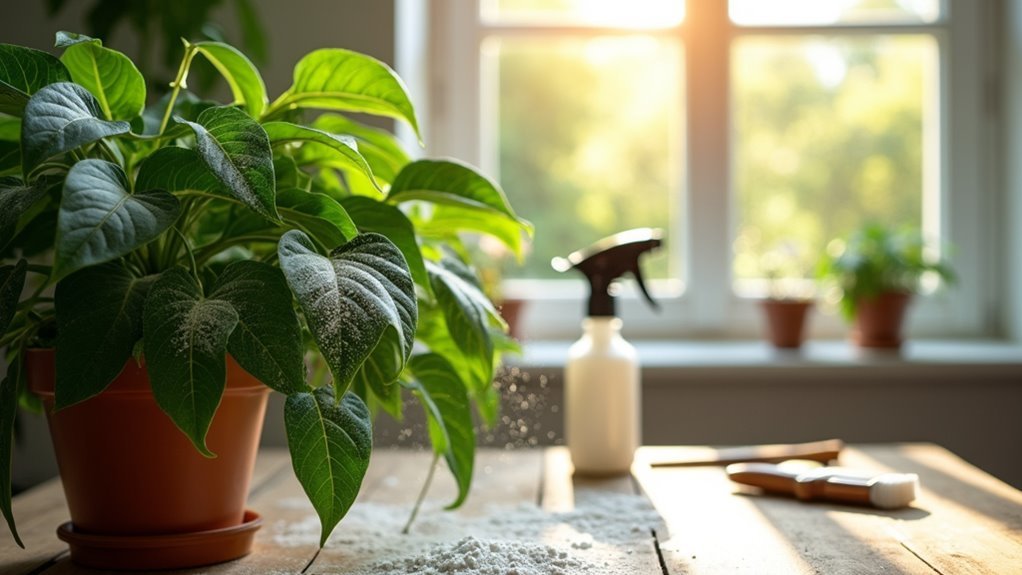
You’ll find diatomaceous earth works effectively against common household pests like ants, aphids, mites, and fungus gnats that threaten your plants.
Focus your application on the soil surface around each plant’s base and directly on any visible pests along the stems.
This creates strategic coverage zones where pests typically travel and establish themselves.
Common Household Pests
Versatility makes diatomaceous earth an excellent choice for controlling common household pests that threaten your indoor plants.
This natural powder targets multiple pest species effectively, making it a thorough solution for your plant protection needs.
Diatomaceous earth works against these common household pests:
- Ants – Disrupts ant trails and colonies around plant containers
- Aphids – Eliminates soft-bodied insects feeding on plant sap
- Mites – Controls spider mites and other microscopic plant parasites
- Fungus gnats – Targets larvae in soil and adult gnats on plant surfaces
The powder’s mechanism damages pest exoskeletons upon contact, causing dehydration and death.
You’ll find diatomaceous earth particularly effective because it provides long-lasting protection while remaining safe for your household environment.
Application Coverage Zones
Three primary zones require targeted diatomaceous earth application to maximize pest control effectiveness around your houseplants.
First, focus on the soil surface where you’ll create a thin, even layer that disrupts pest movement and feeding patterns. This barrier’s particularly effective against ants, aphids, mites, and fungus gnats attempting to access your plants.
Second, apply diatomaceous earth around plant stems where pests often congregate and begin their destructive activities.
Third, identify and treat entry points where insects infiltrate your plant environment, such as drainage holes or pot edges.
You’ll need to reapply after watering or when the barrier appears disturbed.
Monitor your plants regularly for pest activity signs and adjust application zones accordingly to maintain ideal protection and effectiveness.
Reapplication Schedule and Maintenance Tips
While diatomaceous earth provides excellent pest control, maintaining its effectiveness requires consistent reapplication and proper monitoring. Your reapplication schedule should align with your watering routine and pest activity levels.
Consistent reapplication and vigilant monitoring are essential for diatomaceous earth to maintain its pest control effectiveness over time.
Follow these maintenance guidelines:
- Reapply after each watering – Water disrupts the powder’s protective layer, requiring immediate replacement to maintain pest barriers.
- Monitor plants regularly – Check for pest activity weekly and reapply immediately when you spot any insects or signs of infestation.
- Replace disturbed coverage – Reapply promptly if the barrier appears reduced or uneven from wind, rain, or plant movement.
- Store properly – Keep unused powder in a cool, dry place to prevent clumping and preserve effectiveness for future applications.
Combining With Other Natural Pest Control Methods
Although diatomaceous earth works effectively on its own, you’ll achieve superior pest control by combining it with other natural methods. Creating a multi-faceted approach targets various pest life stages while promoting eco-friendly gardening practices.
| Natural Method | Combination Benefit |
|---|---|
| Neem Oil | Disrupts pest life cycles while DE provides physical barriers |
| Beneficial Insects | Ladybugs and lacewings target different pest stages than DE |
| Companion Planting | Repellent plants work with DE to deter specific insects |
| Garlic/Pepper Sprays | Enhanced protection against broader pest arrays |
| Regular Monitoring | Guarantees timely application of multiple deterrents |
When applying diatomaceous earth alongside these methods, you’re creating extensive protection that reduces chemical pesticide reliance while maintaining healthier plants through natural pest management strategies.
Storage and Handling Best Practices
You’ll maximize diatomaceous earth’s effectiveness by storing it properly and handling it safely during application.
Keep your DE in an airtight container within a cool, dry location to prevent moisture absorption that causes clumping and reduces pest control power.
Always wear a dust mask and gloves when applying DE to protect yourself from respiratory irritation and skin contact.
Proper Storage Conditions
Since diatomaceous earth’s effectiveness depends heavily on maintaining its dry, powdery consistency, you’ll need to store it under specific conditions that preserve its pest-fighting properties.
Following proper storage conditions for diatomaceous earth guarantees you’ll have potent pest control material when needed:
- Choose cool, dry locations – Store away from humidity sources like basements, garages, or areas prone to temperature fluctuations that create condensation.
- Use airtight containers – Transfer diatomaceous earth from original packaging into sealed plastic or glass containers to prevent moisture absorption and contamination.
- Avoid direct sunlight – Keep containers in dark spaces since prolonged UV exposure degrades the material’s quality over time.
- Label containers clearly – Mark storage containers with contents and date to prevent confusion with other powdery substances and guarantee safe handling.
Safe Handling Techniques
Proper handling techniques protect both you and your plants when working with diatomaceous earth’s fine particles.
You’ll need to wear a dust mask during application to safeguard your respiratory system from potential irritation caused by airborne powder. These safe handling techniques guarantee you can apply the treatment without health concerns.
Use a scoop or funnel when dispensing diatomaceous earth to minimize dust clouds and achieve precise application.
This controlled approach prevents excessive powder from becoming airborne while targeting specific plant areas effectively.
Keep the product away from children and pets, as large quantities can cause harm if ingested.
Store your unused diatomaceous earth in airtight containers within cool, dry locations to maintain its pest-control effectiveness and prevent moisture-related clumping.
Frequently Asked Questions
How Do You Dust Plants With Diatomaceous Earth?
You’ll lightly sprinkle food-grade diatomaceous earth around your plant’s base, creating a thin soil barrier. Don’t dust foliage directly. Confirm even distribution targeting pest entry points, and reapply after watering or disturbances.
What Does Diatomaceous Earth Do to Plants?
Diatomaceous earth won’t harm your plants since it’s non-toxic to them. However, you shouldn’t apply it on leaves because it’ll cause dehydration and stress if it accumulates on the foliage.
What Are the Downsides of Diatomaceous Earth?
You’ll face several downsides: it dehydrates plant foliage, irritates your respiratory system requiring masks, shows slow pest control results, loses effectiveness without rotation, and becomes less potent when stored improperly.
What Bugs Are Killed by Diatomaceous Earth?
You’ll find diatomaceous earth kills ants, aphids, spider mites, fungus gnats, and other soft-bodied pests. It damages their exoskeletons and absorbs moisture from their bodies, causing dehydration and death.
In Summary
You’ve learned how diatomaceous earth can transform your plant care routine into an effective, natural pest control system. Remember to choose food-grade DE, wear protective gear during application, and maintain consistent dusting schedules for best results. Don’t forget to combine this method with other natural treatments and store your DE properly. With these techniques, you’ll keep your indoor plants healthy while avoiding harsh chemical pesticides that could harm your home environment.

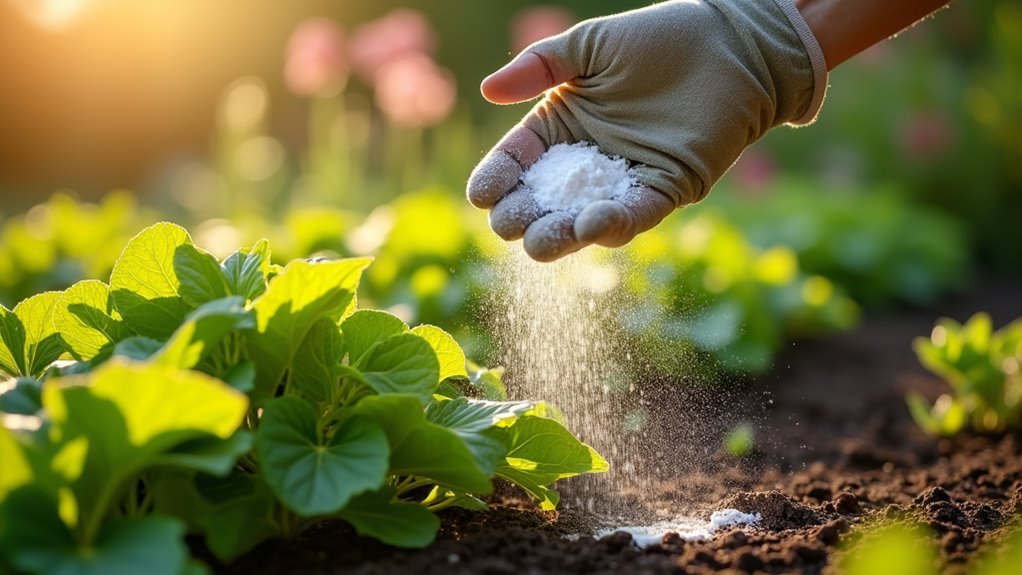
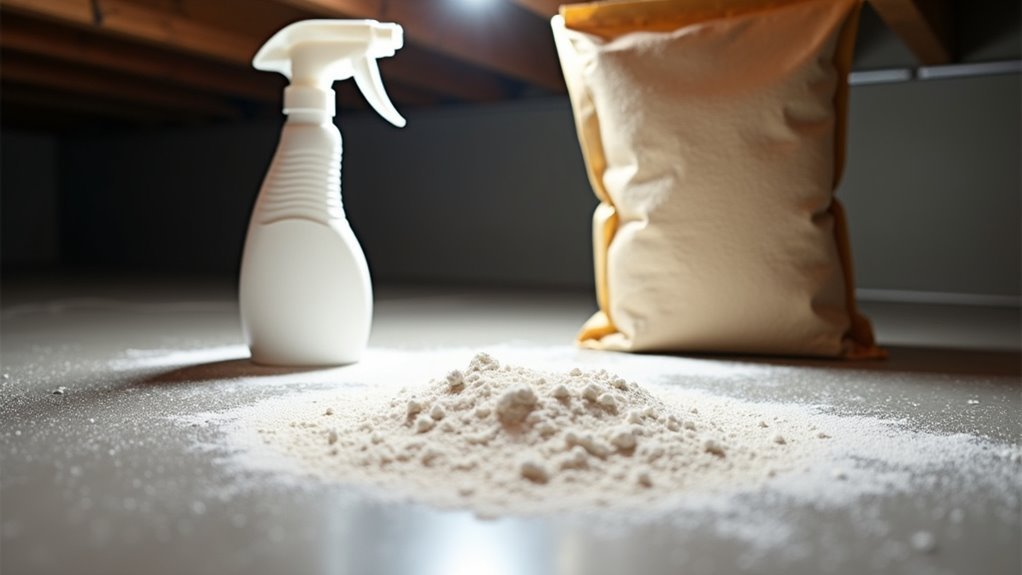
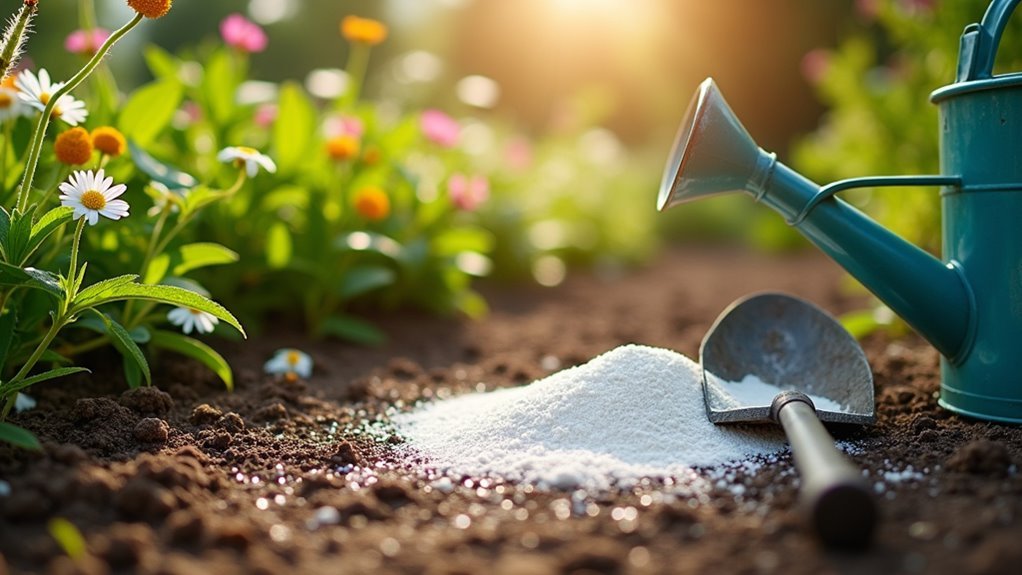
Leave a Reply